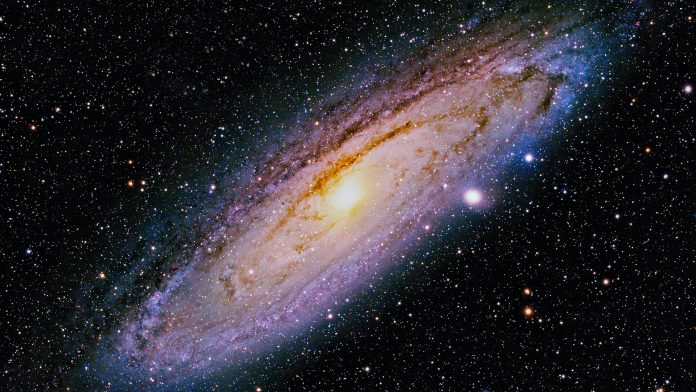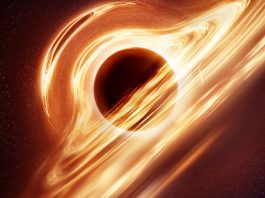A major telescope upgrade has revealed the first galactic spectra 280 million light–years away from Earth.
The William Herschel Telescope (WHT) in La Palma on the Canary Islands has undergone a major upgrade, called the WHT Enhanced Area Velocity Explorer (WEAVE). WEAVE has begun its on-sky commissioning phase and is now ready to reveal galactic spectra over the next five years.
The Science and Technology Facilities Council (STFC) is one of the key partners in the operation of the WHT.
Unlocking the Universe’s secrets with spectroscopy
Astronomers use spectroscopy, which analyses the light detected with a telescope, to reveal scientific information such as the speed of the object observed, the atoms it is made of, and its temperature.
The spectrum of an astronomical object, therefore, tells us what the object is.
First galactic spectra with WEAVE
A galactic spectrum is the combination of spectra from the millions of stars in an observed galaxy. Through the study of a galactic spectrum’s features, astronomers can learn about the types of stars within a galaxy and the abundance of each type. This reveals how the galaxy formed and changed over time.
The astronomers conducted first-light observations with WEAVE and one of WEAVE’s three fibre systems – the large integral-field unit (LIFU) fibre bundle. From this, the team were able to observe the heart of the galaxy group Stephan’s Quintet, a group of five interacting galaxies.
A pair of galaxies, called NGC 7318a and NGC 7318b, located at the centre of a major galaxy collision 280 million light-years from Earth in the constellation Pegasus, were the focus of the instrument.
“The wealth of complexity revealed in this way by a single detailed observation of this pair of nearby galaxies provides insights into the interpretation of the many millions of spectra that WEAVE will obtain from galaxies in the distant Universe and provides an excellent illustration of the power and flexibility of the WEAVE facility,” said Professor Gavin Dalton from the University of Oxford.
The WEAVE LIFU measures separate galactic spectra in 547 different regions around the pair and records the colours of their light from the ultraviolet to the near-infrared.
The galactic spectra unveil the motions of stars and gas, the chemical composition of the stars, the temperatures and densities of the gas clouds, and more. Astronomers will use the data to learn how galaxy collisions transform the galaxies in the group.
“Without even breaking a sweat, WEAVE has provided us with an unprecedented glimpse into the dance of this enigmatic group of galaxies,” said Dr David Murphy from Cambridge’s Institute of Astronomy, lead of spectroscopic pipeline development for WEAVE.
“This exciting initial release provides a snapshot of the various ways the instrument can provide insights into the Universe. Coupled with our rapid-response data-processing pipelines, WEAVE will advance cutting-edge research, ranging from the complex chemical fingerprint of our galactic neighbourhood to the very structure and fabric of our Universe.”
“Our advanced analysis pipeline consists of a chain of more than 20 state-of-the-art modules developed to analyse a wide range of astronomical targets, from newly born hot stars to quasars,” said Dr Alireza Molaeinezhad from Cambridge’s Institute of Astronomy, lead developer of the Advanced Processing System.
“Using this pipeline on the phenomenal first-light data is like wearing 3D-glasses to watch the cosmic dance of galaxies in this system.”
Conducting future surveys
In the next five years, the Isaac Newton Group of Telescopes will assign 70% of the time available on the WHT to eight major surveys with WEAVE. These surveys require spectra of up to millions of individual stars and galaxies, which is now achievable with WEAVE’s ability to observe nearly 1,000 objects at a time.

These eight surveys, which cover studies of stellar evolution, Milky Way science, galaxy evolution, and cosmology, have been organised by over 500 astronomers across Europe. WEAVE will study galactic history and growth, obtaining millions of spectra of stars in the Milky Way.
“This first light event is a milestone for both the international and UK astronomy communities: WEAVE will provide spectra of millions of stars and galaxies over the next five years,” said Professor Mark Thomson, STFC Executive Chair.
“After ten years in development, WEAVE will now finally offer astronomers a new eye to the sky to help them answer questions, such as: what is dark matter and how did stars form in distant galaxies?”
“These wonderful first light images demonstrate the power of WEAVE to unravel the intricate chemo-dynamical processes at work in this galaxy system,” said Dr Nicholas Walton from the Institute of Astronomy and lead of the WEAVE data analysis system development team.
“The analysis of this data, from one of the many observational modes of WEAVE, has used our state-of-the-art science pipelines. We are now ready to handle the nightly data from WEAVE as it embarks on its main science surveys.”









